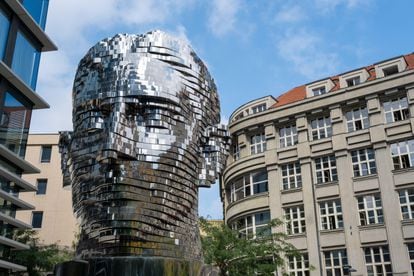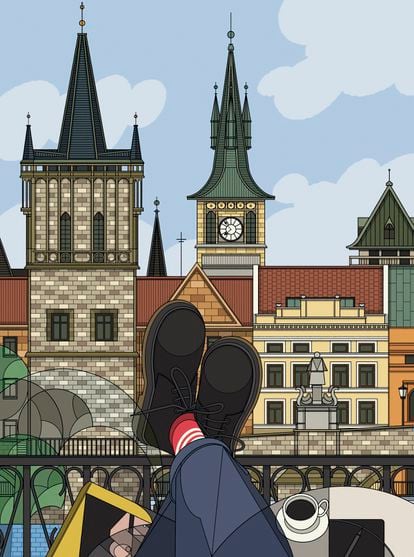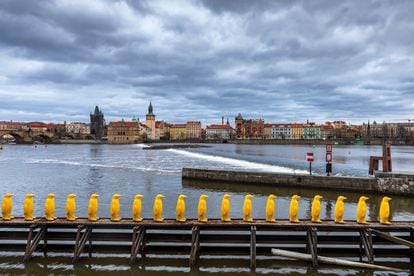- Hans Weber
- July 11, 2025
Kafka’s Prague: a captivating city brimming with literary tradition
Franz Kafka is known for his precise and enthralling writing style. His literary works go beyond published works into letters and diaries that provide insight into his enigmatic persona. Testimonials, studies and new discoveries — Kafka’s essence continues to fascinate readers and leave a lasting impact a century after his death.
Because of his frequent appearances in news articles, Franz Kafka is often considered the most iconic writer of the 20th century. Visiting Prague offers a unique opportunity to delve into Kafka’s world and vision. The Franz Kafka Museum is a marvel for admirers of the author, offering insights into his life, socio-historical context and the city he lived in. Explore first editions of his works, along with a wealth of documents, photographs and audiovisual materials, presented in a meticulously designed exhibition.
About a 10-minute walk from the museum, you’ll find the impressive Prague Castle in the Hradcany neighborhood on the left bank of the Vltava River. Inside the castle grounds, you’ll discover palaces, churches and the cathedral… as well as a charming little street called Zlatá ulička, also known as Golden Lane. One of the houses on this street — number 22 — is where Kafka lived in 1916 and 1917. Although the house was renovated in 1955, it still retains the humble character and low ceilings of the author’s abode a few years before his death.
Tram 22 is the ideal way to explore this area of the Czech capital. To save money and time, purchase a transportation card from the Prague tourist office, as well a visitor pass that gives you direct entry to over 60 places of interest, guided tours and boat trips around the city.

The neighborhood adjacent to Prague Castle is the place about which Jan Neruda wrote his most famous book of short stories. In 1895, the city named a street there after him — Nerudova — undoubtedly one of the most beautiful in Prague. It had been four years since he passed away, and the city decided to honor his childhood home on this street. Prior to 1770, houses in Prague were distinguished by their signs, and Neruda’s home was known as the Two Suns. The author drew inspiration from the innumerable anecdotes and snatches of gossip he heard in his father’s grocery store to write Tales of the Lesser Quarter, a collection of short stories published in 1877.
Hispanic-Czech fusion
In this same charming Prague neighborhood, you’ll find a cozy restaurant called El Centro (Maltézské 293/9, Malá Strana, 118 00). Opened in 1999, it was the first restaurant with Spanish and Central American cuisine in the city. It’s run by Radek Neruda and his wife Norma, a Czech and Guatemalan duo with an interesting personal story. Their restaurant offers a delightful selection of tapas, paellas, Latin American delicacies and a carefully curated selection of Spanish wines. It’s the perfect spot to rest, recharge and enjoy delicious food.

This Hispanic-Czech fusion restaurant is notable because it’s also surrounded by weighty literary tradition. Nearby is the Czech Literary Center (České literární centrum), where Kateřina Chromková promotes Czech writers in other countries. The Prague Cervantes Institute occupies a beautiful and imposing building where its director, novelist Gonzalo Manglano, connects local literature with works in the Spanish language.
The city is a thriving literary hub, hosting various events and offering scholarships for writing and translation through the Czech Literary Center. Initiatives like “Encounters with Literature” promote Hispanic literature and its authors to the Czech public and publishing industry. This focus on the literary world is not surprising in a country that loves radio dramas, reflecting the Czech Republic’s enthusiasm for literature.
On the corner of Dusní and Vezenská streets, in the heart of the ancient Jewish Quarter, stands a monument honoring Kafka created by sculptor Jaroslav Róna and unveiled in 2003. Another famous writer, Jaroslav Hašek, best known for his four-part humorous novel, The Fateful Adventures of the Good Soldier Svejk During the World War (1920-1923), is also honored in various places around Prague. Known for his bohemian lifestyle and anarchist leanings, Hašek fought with the Austrians in World War I and later as a mercenary in the Russian Army. Josef Landa’s iIllustrations of the fictional character of Švejk can be found in several Prague cafés.

Some of Landa’s illustrations adorn the U Brejsku café, a place both Hašek and Kafka frequented. A colossal sculpture of Kafka’s head sits on the outskirts of Quadrio shopping center. Designed by David Černý and installed in 2014, the 24-ton, stainless-steel sculpture has 42 movable sections that rotate independently, creating a mesmerizing facial effect.
Bothšek and Kafka also frequented literary cafés like the Louvre, a charming establishment that has maintained its beauty since it opened in 1902. Inside, you can find images and information commemorating visits by Kafka and other writers, including Karel Čapek, who coined the term “robot” in one of his science fiction plays. Albert Einstein even paid a visit once. The restaurant is highly recommended for its Czech cuisine, particularly the delicious roast pork with pasta, a dish that truly represents local flavors.
Equally impressive is the elegant Slavia café, open since 1884. Its walls are adorned with photographs of renowned writers, especially former president and playwright, Vaclav Havel. During the post-Soviet collapse of the 1990s, Havel played a crucial role in saving the establishment after the fall of the Berlin Wall. Another notable spot is U zlatého tygra (The Golden Tiger), where Bohumil Hrabal would often spend entire days. Finding a seat can be challenging in this popular tavern housed in a 14th-century building that features a Gothic portal and painting dedicated to the 20th-century Czech writer.

For more literary exploration, check out museums like the National Gallery of Prague, the DOX Center for Contemporary Art, the Kampa Museum, the Kunsthalle Praha, and the recently opened Museum of Literature. And of course, you can’t miss all the places associated with Kafka, from his burial site at the immense Olšanské hřbitovy Cemetery to his birthplace near Staroměstské náměstí Square.
Attached to the Old Town Hall in Prague is the renowned 15th-century astronomical clock, a ubiquitous sight (in miniature) in every souvenir shop. Every hour, figures of the 12 Biblical apostles spring into motion, drawing huge crowds of fascinated tourists. Surrounding the clock, four allegorical figures symbolize Vanity, Greed, Death and Lust, encapsulating large parts of our shared human experience.
Recent posts
See AllPrague Forum Membership
Join us
Be part of building bridges and channels to engage all the international key voices and decision makers living in the Czech Republic.
Become a member